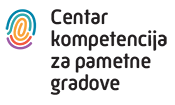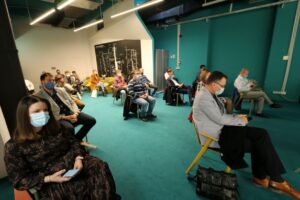With an increased growth of cities and population that is tied to them, challenges with transport are growing. Traffic jams, traffic safety, travel speed, pollution and other environmental challenges affect the economy, and thus the quality of life, so the smart solutions industry for the smart cities is focused on solving problems related to traffic and mobility.
In CEKOM, we face challenges through two research-developmental projects:
- Through Connected Traffic, an advanced information and communication system will serve as a support to decision making and in the urban mobility management itself. Furthermore, the concept should enable more efficient use of public-private infrastructure, resources and property in the field of transport with the aim of protecting environment, increasing safety, and achieving the sustainability of the transport system in the urban area.
- Projects and products developed through Surinmo optimize traffic flows and reduce stationary traffic, so visible results are expected in terms of quality of traffic, from its safety to being informed.
The research within the TRL2 phase of Connected Traffic, which aims to establish an advanced information and communication system, i.e. an integrated platform for a decision making support in urban and multimodal transport and sustainable mobility management, also included examples of good practice in traffic management in individual cities researched by the partner Maritime Faculty in Rijeka.

With the arrival of private bus carriers for the transport of passengers in the city of Dublin, a system for monitoring passenger information in real time (RTPI-Real-time passenger information) was introduced with the aim of improving the accuracy of travel planning. The real-time access to information can be achieved in several ways, such as by entering the bus station number on the Dublin Bus website or using the Dublin Bus application. Also, real-time information can be searched by entering the bus station number, bus line route, bus station address and by map searching on the Dublin Bus website. With the help of the automatic transmitters that are built into the buses, i.e. by monitoring the bus via GPS, the operation of the information system for the bus arrival is enabled, while the software predicts the time of arrival at the next bus station. The vehicle location system is in charge of updating the data while sending information at intervals of 30 seconds, thus ensuring accuracy of arrival time of the bus shown on the information screen.
With the combined volumetric pedestrian detection and SCOOT (Split Cycle and Offset Optimization Technique system) approach, the intelligent pedestrian crossings based on pedestrian density recognition have been implemented in London, and traffic light changes accordingly. In order to achieve better and safer pedestrian crossing over pedestrian crossings without slowing down the traffic, the system uses video cameras that count pedestrians waiting at the pedestrian crossing, and if the camera detects a large number of pedestrians, the system allows them to cross the street. However, if there is no one at the crossing or if someone presses the crossing button and then crosses the red light or gives up, the system will give up the green light. On average, the SCOOT system reduces the waiting time of vehicles in traffic by 12.5%, while the reduction in the number of vehicles to be stopped during the trip through the transport network is 4.6%.
One of the ways to prevent traffic congestion on the main roads in Stockholm was to introduce tolls for certain parts of the city, i.e. the zones where tolls would be charged for the entry of vehicles (congestion pricing). Eighteen electronic checkpoints have been established at all entrances to the congestion zone, while charges apply to entry and exit from the area. As a result of this strategy, traffic was reduced by approximately 20% through the toll zone, which is equivalent to 100,000 tolls. The congestion reduction on the main roads is 30-50%, and at the same time the emission of harmful exhaust gases within the city is reduced by 10-14%. The toll zone has a positive impact on shorter and more reliable travel times, lower greenhouse gas emissions, a favorable impact on health and the environment, increased traffic safety, and increased revenues from the public transport.
The increase in the number of vehicles with the growing number in lack of parking spaces has forced the city of Vienna to take measures to develop a parking space management plan. As a result of these efforts, a large part of the population began to use alternative means of transport, bicycles and public transport, which significantly contributed to the quality of life and environmental protection. The improvement of the city transportation system was followed by the installation of parking garages that were used on the principle of “Park and Ride” system, parking near public transport, which allows leaving the vehicle while continuing traveling by public transport. All revenues generated through the parking management are intended for the Vienna transport system and must be used for the purpose of improving public transport garages, developing traffic safety measures, etc.

Traffic management in Troyes was improved in 2013 creating the traffic management system based on a centralized architecture. Within the traffic management system, a radio system has been installed which gives priority to buses as mean of public city transport. Each bus is automatically located, transmits a position and sends a priority request via radio communication directly to the traffic control center, which then processes the data and assigns an early green or supplementary green light via direct communication with the controller. The application of the radio system for giving priority requests resulted in an average of 5-minute shorter bus ride on the public city transport. The city of Rennes and its development of a centralized architecture based on a priority algorithm are on a similar track.
The Grenoble agglomeration has launched an innovative traffic management approach, aimed at building a multimodal partnership that exchanges information and coordinates activities. Such a solution collects and centralizes information such as static data (network description) or dynamic data (traffic disruptions, incidents, or road works) that different centers receive within the real time. An agency for multimodal mobility (Shared-Use Mobility Center) has also been opened with an aim to gather in one place the “sale” of all available modes of transportation. The agency provides information and advice, while raising the awareness of citizens about the use of alternative modes of transport to their cars.



